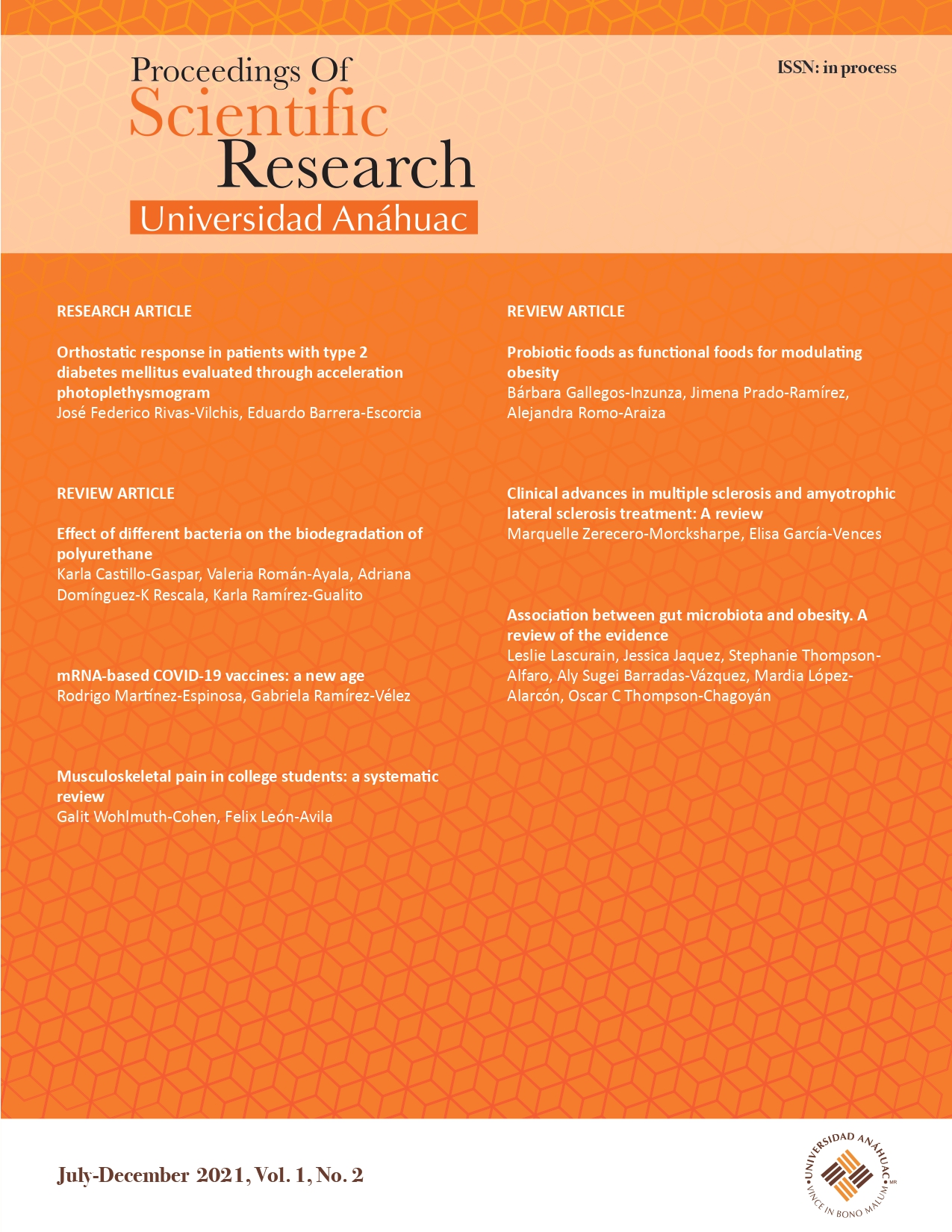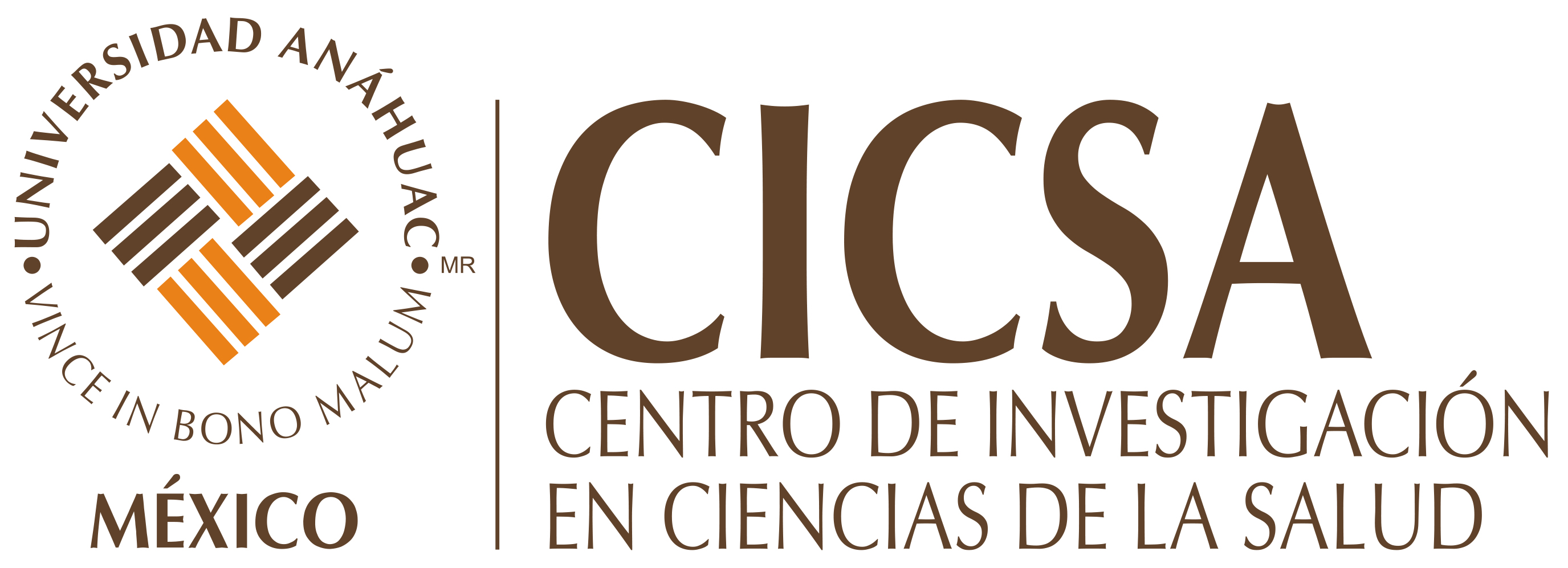Effect of different bacteria on the biodegradation of polyurethane
DOI:
https://doi.org/10.36105/psrua.2021v1n2.02Keywords:
bacteria, biodegradation, poly(ether urethane), biotechnologyAbstract
Polyurethane has been used and over-exploited worldwide in the manufacture of different goods, but it is hard to break down and represents an important contaminant due to its accumulation when discarded. Recent research findings have shown that several bacteria and their enzymes can biodegrade various plastics, such as polyurethane. In this review, we sought to group, analyze, and relate the techniques used by different bacterial species to biodegrade polyurethane that have been identified in different studies by searching databases, such as PubMed, Web of Science, and Scopus. Different species of proteobacteria, actinobacteria, and endobacteria biodegrade polyurethane by oxidation and hydrolysis to obtain carbon and nitrogen sources. Changes as weight loss, tensile strength, and chemical and surface changes were observed in polymer properties, showing that biological technologies have a direct impact on polyurethane by modifying the molecule in different ways.
Downloads
PLUMX metrics
References
2. Solís-González CJ, Domínguez-Malfavón L, Vargas-Suárez M, Gaytán I, Cevallos MÁ, Lozano L, Loza-Tavera H. Novel Metabolic Pathway for N-Methylpyrrolidone Degradation in Alicycliphilus sp. Strain BQ1. AEM [Internet]. 2017 [cited Oct 18, 2020];84(1). https://doi.org/10.1128/AEM.02136-17
3. Oceguera-Cervantes A, Carrillo-García A, López N, Bolaños-Nuñez S, Cruz-Gómez MJ, Wacher C, et al. Characterization of the Polyurethanolytic Activity of Two Alicycliphilus sp. Strains Able To Degrade Polyurethane and N-Methylpyrrolidone. AEM [Internet]. 2007 [cited Oct 18, 2020];73:6214–23. https://doi.org/10.1128/AEM.01230-07
4. Stepien AE, Zebrowski J, Piszczyk Ł, Boyko VV, Riabov SV, Dmitrieva T, et al. Assessment of the impact of bacteria Pseudomonas denitrificans, Pseudomonas fluorescens, Bacillus subtilis and yeast Yarrowia lipolytica on commercial poly (ether urethanes). Polym Test [Internet]. 2017 [cited Oct 18, 2020]; 63:484-493. https://doi.org/10.1016/j.polymertesting.2017.08.038
5. Plastics Europe. Plastics—the facts 2015. Plastics-Europe [Internet]. 2015 [cited Oct1 8, 2020];33(2)
6. Mahajan N, Gupta P. New insights into the microbial degradation of polyurethanes. RSC Adv [Internet]. 2015 [cited Oct 18, 2020];5:41839–41854. https://doi:10.1039/C5RA04589D.
7. Ru J, Huo Y, Yang Y. Microbial Degradation and Valorization of Plastic Wastes. Frontiers in Microbiology [Internet]. 2020 [cited Feb 6, 2021];11. https://doi.org/10.3389/fmicb.2020.00442
8. Azubuike CC, Chikere CB, Okpokwasili, GC. Bioremediation techniques‐classification based on site of application: principles, advantages, limitations and prospects. World J Microbiol Biotechnol [Internet]. 2016 [cited Oct 18, 2020];32(180). https://doi.org/10.1007/s11274-016-2137-x
9. Peng Y, Shih Y, Lai Y, Liu Y, Liu Y, Lin N. Degradation of polyurethane by bacterium isolated from soil and assessment of polyurethanolytic activity of a Pseudomonas putida strain. Environ. Sci. Pollut. Res [Internet]. 2015 [cited Oct 18, 2020];21(16):9529–9537. https://doi.org/10.1007/s11356-014-2647-8.
10. Amobonye A, Bhagwat P, Singh S, Pillai S. Plastic biodegradation: Frontline microbes and their enzymes. Science of the Total Environment [Internet]. 2021 [cited Feb 6, 2021];759. https://doi.org/10.1016/j.scitotenv.2020.143536
11. Hung CS, Zingarelli S, Nadeau LJ, Biffinger JC, Drake CA, Crouch AL, Barlow DE, Russell JN Jr, Crookes-Goodson WJ. Carbon catabolite repression and impranil polyurethane degradation in Pseudomonas protegens strain Pf-5. Appl Environ Microbiol [Internet]. 2016 [cited Oct 18, 2020];82:6080–6090. https://doi.org/10.1128/AEM.01448-16.
12. Biffinger JC, Barlow DE, Cockrell AL, Cusick KD, Hervey WJ, Fitzgerald LA, Nadeau LJ, Hung CS, Crookes-Goodson WJ, Russell JN. The applicability of Impranil® DLN for gauging the biodegradation of polyurethanes. Polym Degradation Stab [Internet]. 2015 [cited Oct 18, 2020];120:178-185. https://doi.org/10.1016/j.polymdegradstab.2015.06.020.
13. Glaser JA. Biological Degradation of Polymers in the Environment. Plastics in the Environment [Internet]. 2019 [cited Oct 18, 2020]. https://doi.org/10.5772/intechopen.85124.
14. Gamerith C, Herrero-Acero E, Pellis A, Ortner A, Vielnascher R, Luschnig D, Zartl B, Haernvall K, Zitzenbacher S, Strohmeier G, et al. Improving Enzymatic Polyurethane Hydrolysis by Tuning Enzyme Sorption. Polym. Degrad. Stab [Internet]. 2016 [cited Oct 18, 2020]132:69–77. https://doi.org/10.1016/j.polymdegradstab.2016.02.025
15. Wei R, Oeser T, Then J, Kühn N, Barth M, Schmidt J, Zimmermann W. Functional Characterization and Structural Modeling of Synthetic Polyester-Degrading Hydrolases from Thermomonospora curvata. AMB Express [Internet]. 2015[cited Oct 18, 2020];4(44). https://doi.org/10.1186/s13568-014-0044-9.
16. Miyakawa T, Mizushima H, Ohtsuka J, Oda M, Kawai F, Tanokura M. Structural Basis for the Ca2+-Enhanced Thermostability and Activity of PET-Degrading Cutinase-Like Enzyme from Saccharomonospora viridis AHK190. Appl. Microbiol. Biotechnol [Internet]. 2015 [cited Oct 18, 2020];99:4297–4307. https://doi.org/10.1007/s00253-014-6272-8
17. Schmidt J, Wei R, Oeser T, Dedavid e Silva L, Breite D, Schulze A, Zimmermann W. Degradation of polyester polyurethane by bacterial polyester hydrolases. Polymers [Internet]. 2017 [cited Oct 18, 2020];9(2):65. https://doi.org/10.3390/polym9020065
18. Martinez-Martinez M, Coscolin C, Santiago G, Chow J, Stogios PJ, Bargiela R, et al. Determinants and prediction of esterase substrate promiscuity patterns. ACS Chem Biol [Internet]. 2018 [cited Oct 20, 2020];13:225–234. https://doi.org/10.1021/acschembio.7b00996
19. Nakkabi A, Sadiki M, Fahim M, Ittobane N, Ibnsouda-Koraichi S, Barkai H, El Abed S. Biodegradation of Poly (ester urethane)s by Bacillus subtilis. Int. J. Environ. Res [Internet]. 2015 [cited Oct 20, 2020];9(1):157–162. https://doi.org/10.22059/IJER.2015.885
20. Awasthi S, Srivastava P, Singh P, Tiwary D, Mishra PK. Biodegradation of thermally treated high-density polyethylene (HDPE) by Klebsiella pneumoniae CH001. 3 Biotech [Internet]. 2017 [cited Oct 20,2020];7(10). https://doi.org/10.1007/s13205-017-0959-3.
21. Fotopoulou KN, Karapanagioti HK. Degradation of Various Plastics in the Environment. Handb. Environ. Chem [Internet]. 2017 [cited Oct 20, 2020]; 78:71-92. https://doi.org/10.1007/698_2017_11
22. Deroiné M, Le Duigou A, Corre YM, Le Gac PY, Davies P, César G, Bruzauda S. Accelerated ageing of polylactide in aqueous environments: Comparative study between distilled water and seawater. Polym. Degrad. Stab [Internet]. 2014 [cited Feb 6, 2021];108:319-329. https://doi.org/10.1016/j.polymdegradstab.2014.01.020
23. Da Fonte Porto Carreiro A, Dos Santos Cruz CA, Vergani CE. Hardness and compressive strength of indirect composite resins: effects of immersion in distilled water. J Oral Rehabil [Internet]. 2004 [cited Feb 6, 2021];31(11): 1085-1089. https://doi.org/10.1111/j.1365-2842.2004.01147.x
24. Sarkhel R, Sengupta S, Das P, Bhowal A. Comparative biodegradation study of polymer from plastic bottle waste using novel isolated bacteria and fungi from marine sources. J. Polym. Res [Internet] 2019 [cited Oct 20, 2020]; 27(16). https://doi.org/10.1007/s10965-019-1973-4
25. Skariyachan S, Setlur AS, Naik SY, Naik AA, Usharani M, Vasist KS. Enhanced biodegradation of low and high-density polyethylene by novel bacterial consortia formulated from plastic-contaminated cow dung under thermophilic conditions. Environ. Sci. Pollut. Res [Internet]. 2017 [cited Oct 20, 2020];24(9):8443-8457. https://doi.org/10.1007/s11356-017-8537-0
26. El-Wakil AEAA, Moustafa H, Youssef AM. Antimicrobial low-density polyethylene/low-density polyethylene-grafted acrylic acid biocomposites based on rice bran with tea tree oil for food packaging applications. J. Thermoplast. Compos. Mater [Internet]. 2020 [cited Oct 20, 2020];0(0). https://doi.org/10.1177/0892705720925140 0892705720925140
27. Kupka V, Benesova P, Obruca S, Brtnikova J, Marova I, Jancar J, Vojtova L. Biodegradation of polyurethane-polyhydroxybutyrate elastomeric composite investigated from morphological and structural viewpoint. J. Appl. Polym. Sci [Internet]. 2018 [cited Feb 6, 2021];46909. https://doi.org/10.1002/app.46909
28. Sarmah P, Rout J. Efficient biodegradation of low-density polyethylene by cyanobacteria isolated from submerged polyethylene surface in domestic sewage water. Environ. Sci. Pollut. Res [Internet]. 2018 [cited Oct 20, 2020]; 25(33):33508-33520. https://doi.org/10.1007/ s11356-018-3079-7
29. Shalini R, Sasikumar C. Biodegradation of Low Density Polythene materials using microbial consortium – An overview. International Journal of Pharmaceutical and Chemical Sciences [Internet]. 2015 [cited Feb 7, 2021];4: 507- 514.
30. Novotný Č, Malachová K, Adamus G, Kwiecień M, Lotti N, Soccio M, Verney V, Fava F. Deterioration of irradiation/high-temperature pretreated, linear low-density polyethylene (LLDPE) by Bacillus amyloliquefaciens. Int. Biodeterior. Biodegradation [Internet]. 2018 [cited Oct 20, 2020];132:259-267. https://doi.org/10.1016/j.ibiod.2018.04.014.
Downloads
Published
How to Cite
Issue
Section
License
Copyright (c) 2021 Karla Castillo-Gaspar, Valeria Román-Ayala, Adriana Domínguez-K Rescala, Karla Ramírez-Gualito

This work is licensed under a Creative Commons Attribution-NonCommercial-NoDerivatives 4.0 International License.
All the intellectual content found in this publication is licensed to the consumer public under the figure of Creative Commons©, unless the author of said content has agreed otherwise or limited said faculty to "Proceedings of Scientific Research Universidad Anáhuac. Multidisciplinary Journal of Healthcare©" or "Universidad Anáhuac Mexico©" in writing and expressly.
Proceedings of Scientific Research Universidad Anáhuac. Multidisciplinary Journal of Healthcare is distributed under a Creative Commons Attribution-NonCommercial-NoDerivatives 4.0 International License.
The author retains the economic rights without restrictions and guarantees the journal the right to be the first publication of the work. The author is free to publish his article in any other medium, such as an institutional repository.













